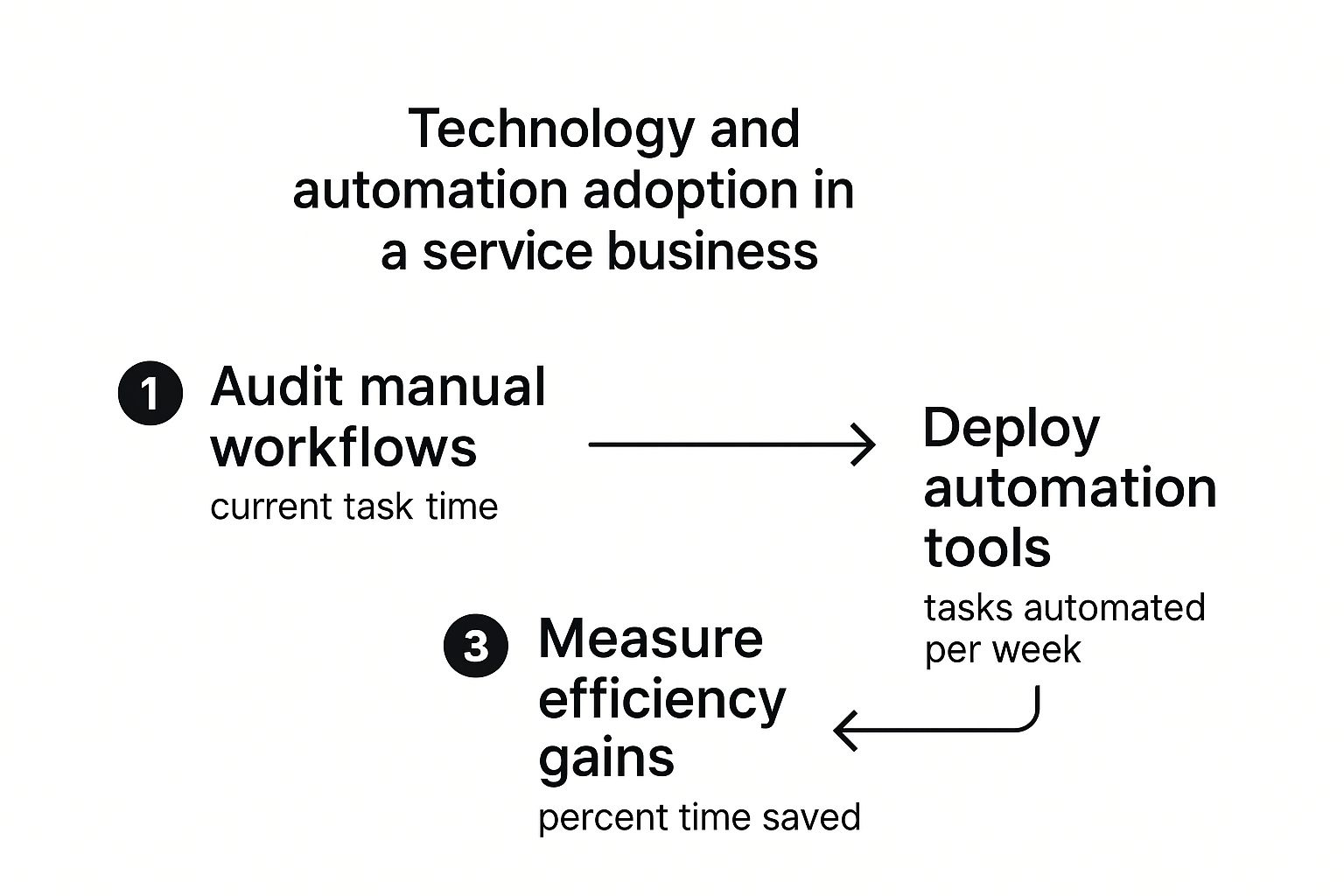Does this sound familiar? You're buried in client work, juggling endless tasks, and every critical decision still lands on your desk. The reward for all your success is a 60-hour work week and the constant fear that the whole operation would collapse if you dared to take a vacation. You're stuck in the business, not working on it.
The good news? You can start breaking free this week with one small change.
Your Quick Win: Pinpoint one recurring, low-risk task you do every single week. Maybe it's compiling a report, sending payment reminders, or scheduling social media posts. Next, document the process with a simple checklist or a quick screen recording. Then, hand it off to a team member or a virtual assistant. This single act of delegation is your first step toward building a business that runs on systems, not just your heroic effort.
Escaping the Founder Trap to Begin Scaling
The "founder trap" is the biggest barrier to growth. It's the point where your personal capacity becomes the company's revenue ceiling. To scale, you must shift from being the primary "doer" to the architect of the systems that get the work done without you.
This journey is about creating repeatable processes that deliver consistent, high-quality work, allowing you to bring on more clients without creating more chaos.
Mini-Case Study: From Burnout to Breakthrough
Let's look at "PixelPerfect," a design agency run by its founder, Sarah. For two years, Sarah was the lead designer, project manager, and sales department. She hit a revenue ceiling of $15,000 per month, was completely maxed out, and turning away good projects.
Her first move was to standardize her most popular service: the branding package. She built a detailed project template in her client management tool, outlining every single phase, task, and deliverable. Then, she hired a junior designer and delegated the initial design drafts using her new, standardized process.
This one change freed her up to focus on closing new deals and providing high-level client strategy. Within six months, PixelPerfect was handling twice the project volume with less stress. Sarah was finally working on her business, not just in it. This is the power of moving from founder-led chaos to system-driven scale.
The Three Pillars of Sustainable Growth
Sarah's success wasn't magic; it was a result of focusing on three pillars essential for scaling any service business:
- Standardized Delivery: Creating repeatable processes (SOPs) for your core services to ensure every client gets the same high-quality experience.
- A Smart Tech Stack: Using tools to automate manual work, centralize communication, and manage projects efficiently.
- A Scalable Team: Strategically hiring and empowering your team to own their roles and outcomes, not just check off tasks.
These pillars are not just theory. The demand for specialized services is exploding—the global business services market was valued at $203.7 billion in 2023 and is projected to hit $1.38 trillion by 2032. This growth is driven by businesses needing experts. To learn more, explore proven growth strategies for scaling or review the full market analysis from Custom Market Insights.
By zeroing in on these core areas, you can build the operational engine for real, sustainable growth.
Standardizing Your Service for Predictable Quality
Inconsistency is a silent killer of growth. If Client A gets a completely different experience than Client B, you can't scale. Your quality can't be a roll of the dice.
Here's how to create predictable, high-quality outcomes for every client, every time.
Step 1: Create Your Service Blueprint
To scale, you need a master Service Blueprint—a Standard Operating Procedure (SOP) that maps out every step of your service delivery. Think of it as a recipe. A master chef doesn't "wing it"; they follow precise instructions. Your service blueprint does the same for your business.
This systematic approach is a core part of effective business process improvement methods. It forces you to define what "quality" means and turns vague ideas into concrete, trainable actions.
Step 2: Break It Down into Phases and Tasks
Let's use a web design agency as an example. Their "5-Page Website" blueprint could be broken down like this:
- Phase 1: Kickoff & Discovery: A specific list of questions for the kickoff call, a mandatory client intake form, and a predefined shared folder structure.
- Phase 2: Design & Mockups: A formal process for presenting mockups, a standardized way to collect feedback, and a clear "two revision rounds" policy.
- Phase 3: Development: A task list for developers, including pre-launch QA checks for mobile responsiveness, browser compatibility, and site speed.
- Phase 4: Launch & Handoff: A final launch-day checklist, a documented process for transferring site ownership, and a templated "project complete" email.
By rolling out this blueprint, the agency cut project completion time by 20% and nearly eliminated scope creep.
Step 3: Embed SOPs into Your Workflow
Creating SOPs is easy. Getting your team to use them is the challenge. The key is to bake them directly into your daily workflow.
Inside growlio, you can build your service blueprint into a project template. When you start a new project, all the phases, tasks, and checklists are automatically generated and assigned. This makes following the process the path of least resistance. It’s no longer extra work; it’s just the work.

Pro Tip: Use Video SOPs for Complex Tasks
For tasks too nuanced for a checklist, record a short (2-5 minute) video with a tool like Loom.
Create video SOPs for things like:
- How to set up a new client's analytics dashboard.
- The steps for running a technical site audit.
- How to format and export the final monthly report.
Link these videos directly within your task descriptions in growlio. This is far more effective for training and ensures tricky procedures are done correctly every time.
With standardized processes embedded in your workflow, you have the foundation for predictable quality, ready to support growth.
Building Your Tech Stack for Operational Efficiency
Are you drowning in spreadsheets and chasing down files in endless email threads? Manual chaos is the enemy of scale. When your day is spent on administrative busywork, growth grinds to a halt. Here's the step-by-step guide to building a tech stack that works for you, not against you.
Step 1: Identify Your Core Needs
Every scalable service business needs a handle on four key areas:
- Client & Project Hub: A central source of truth for all client information, projects, tasks, and communication.
- Communication: Tools that pull conversations out of cluttered inboxes for clear team and client discussions.
- Finance & Invoicing: Software to automate proposals, contracts, invoicing, and payment processing.
- Automation Connectors: Services like Zapier or Make to connect your tools and eliminate manual data entry.
Mastering sales process automation is practically a growth playbook, boosting efficiency and helping you bring in more clients.
Step 2: Choose Your Platform Strategy (All-in-One vs. Specialized)
You can use an all-in-one platform or piece together specialized tools. This choice has major implications for how you scale.
| Factor | All-in-One Platform (e.g., growlio) | Specialized Tools (e.g., Slack + Asana + Google Drive) |
|---|---|---|
| Simplicity | A single interface and one subscription. Easier for your team to adopt and use consistently. | Juggling multiple logins, subscriptions, and interfaces. Can get confusing fast. |
| Integration | Features are built to work together seamlessly. No data silos or clunky workarounds. | Requires third-party connectors (like Zapier), which can be complex and sometimes break. |
| Cost | Often more cost-effective with one predictable fee. | Costs can sneak up. Per-user pricing for multiple tools can balloon as you grow. |
| Functionality | Might have less depth in one specific area compared to a dedicated tool. | Deep, best-in-class functionality for each specific task. |
For most service businesses serious about scaling, an all-in-one platform like growlio offers the most direct path. It eliminates the headache of managing disparate systems, letting you focus on standardizing your service.
Step 3: Implement and Automate
Once you have your tools, put them to work. The goal is to create a unified workflow that saves time and reduces errors.
For example, a marketing agency used growlio to connect their sales and project management. The moment a deal was marked "won," it automatically kicked off a project using their standard onboarding template. This populated all tasks, assigned them, and sent a welcome email to the client.
UI Call-out: In the growlio sales pipeline, moving a deal to the "Won" column can trigger an automation that creates a new client project instantly.

This simple automation cycle—auditing manual work, deploying automation to fix it, and measuring the time saved—is what unlocks sustainable growth.
Structuring Your Team for Next-Level Growth

Hiring without a plan leads to chaos, messy handoffs, and you becoming a full-time manager. To scale effectively, you need a strategic approach to building your team.
Step 1: Adopt the "Core Team + Specialist" Model
The classic mistake is hiring junior versions of yourself. This doesn't free you up; it just turns you into a task manager. A smarter approach is the “Core Team + Specialist Contractors” model.
Build a small, permanent team focused on client strategy and operations. Supplement this core crew with a network of trusted freelance specialists (copywriters, developers, etc.) who you can bring in on a project basis. This keeps overhead lean and gives you the agility to tackle diverse projects without committing to a dozen full-time salaries.
Step 2: Make Your First Key Hire an Operator, Not a Doer
Your gut might scream, "I need another me!" But your first critical hire should be an Operations Manager or a Client Success Manager.
This person's entire job is to own the systems you've built. They manage project timelines, handle client communications, and ensure your SOPs are followed. Hiring for this role first frees up your most valuable asset—your time—so you can focus on sales and business development.
Step 3: Use Role Scorecards, Not Job Descriptions
Most job descriptions are useless lists of tasks. To build a team of owners, use Role Scorecards. A scorecard defines success, outlining three things for every position:
- Mission: A single sentence stating the role's primary purpose.
- Outcomes: 3-5 measurable results the person is expected to achieve (KPIs, not tasks).
- Competencies: The key skills and behaviors required to thrive.
This shifts the dynamic from "what you do" to "what you must achieve." For tracking these metrics, a dedicated CRM for software agencies helps monitor client health and team performance against these outcomes.
Pro Tip: Delegate Outcomes, Not Tasks
There’s a world of difference between asking someone to "send the weekly client report" and empowering them to "ensure client satisfaction stays above 90% by providing clear, proactive weekly updates."
The first is a task; the second is an outcome. When you delegate outcomes, you give your team the autonomy to solve problems. You're no longer the source of all the answers, and that’s the key to stepping back.
This transition in how you structure and manage your team is how you go from being a freelancer with employees to the leader of a scalable service business.
Creating Your Scalable Client Acquisition Engine
You’ve productized your services and your team is ready, but your lead flow is a rollercoaster. This feast-or-famine cycle is a scaling killer. It makes it impossible to hire with confidence or predict revenue. Here's how to build an engine that consistently fuels your business with new clients.
Step 1: Define Your Ideal Client Profile (ICP)
An ICP isn't marketing jargon; it’s a strategic filter for your entire business. Get crystal clear on who you love to help—the clients who get your value, pay on time, and are a pleasure to work with.
To build your ICP, ask:
- What niche or industry are they in? "B2B SaaS companies with 50-200 employees" is an ICP. "Tech" is not.
- What's their size or annual revenue?
- What big problem do you solve better than anyone else?
- What are the red flags of a bad-fit client?
Knowing this transforms your sales from a scattergun approach into a precision strike.
Step 2: Build a Repeatable Sales Process
You need a reliable system for turning prospects into clients. A simple yet powerful sales process looks like this:
- Intake & Qualification: A prospect fills out a detailed form on your site, which you use to check against your ICP.
- Discovery Call: A structured, 20-minute call to diagnose their challenges and confirm fit.
- Proposal & Agreement: Send a standardized proposal outlining scope, timeline, and investment. Our guide on consulting services proposal examples can help.
- Closing & Onboarding: The client signs, and you have a smooth process to hand them off to your delivery team.
This builds immense trust and positions you as a professional, not just another freelancer.

Step 3: Systematize the Client Experience
A fantastic client experience can't hinge on the founder's personal touch forever. It must be a system. This means proactive communication, scheduled check-ins, and a formal process for gathering feedback. Part of this involves knowing how to scale content creation to provide ongoing value.
Tools like growlio are invaluable here. A client health dashboard lets you track communication, project milestones, and satisfaction scores in one place, helping you spot issues before they escalate.
Pro Tip: Automate Your Client Check-Ins
In your project management tool, set up a recurring weekly task for each Client Manager named "Proactive Client Check-In."
In the task description, add this mini-checklist:
- Review project progress against timeline.
- Find one specific "win" to share.
- Anticipate one question they might ask.
- Draft and send a concise update email.
This tiny system ensures no client ever feels forgotten and shifts your team from reactive fire-fighting to proactive relationship management.
With a focused ICP, a repeatable sales process, and a systematic approach to client management, you have a true client acquisition engine built for scale.
Putting It All Together with growlio
Feeling like you're trying to glue a bunch of random parts together? That's a classic growing pain. Your SOPs are in Google Docs, tasks are in Asana, client emails are in Outlook, and invoices are somewhere else entirely. This friction is what holds you back.
This is where an all-in-one platform like growlio becomes essential. It’s designed to be the central nervous system for your business, connecting your processes, people, and client work in one unified hub.
By bringing client acquisition, project delivery, and financial reporting under one roof, you eliminate the operational drag that’s been holding your business back.
Pro tip for advanced users:
Once your core operations are centralized, build smart automations. Within growlio, you can set up a rule to monitor client engagement. For example: if no communication has been logged with a client for 7 days, the system can automatically create a "Proactive Check-In" task for their Client Manager. This turns great relationship management into a reliable, automated process.
You now have the complete roadmap for how to scale a service business. The only thing left is to take action.
Ready to build the operational engine that will drive your growth? See how growlio can unite your clients, projects, and finances into a single, cohesive platform. Start your free growlio account today and begin building the systems that will truly scale your business.
